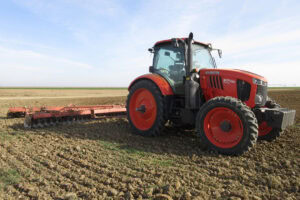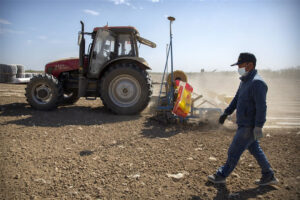Who is afraid of autonomous tractors?

The breakthrough of autonomous tractors and implements will create winners and losers. And whoever is afraid of it, will belong to the latter.
Tractors with RTK-GPS autosteering work more consistently than humans. Farming practice has already proven that. Worldwide, large arable farms have embraced autosteering. Autonomy is therefore a logical next step. One that some people however fear.
Large arable farms in countries like the U.S. cannot function without RTK-GPS autosteering. They are used to the fact that seeding operations can continue in low-visibility conditions (darkness, dust, fog) thanks to the RTK-GPS autosteering. And they have renounced those annoying far-out row markers. Row markers are therefore no longer a limitation for the working width. The Australian company Multi Farming Systems, for example, is developing a 92-meter-wide seed drill. That would be impossible with steel row markers.
What’s stopping autonomous tractors?

The autonomous tractor is an inevitable further development of the autopilot. From a technical point of view, these robot tractors are ready. Especially for simple operations such as cultivating. You can already buy robot tractors in some countries and various suppliers provide autonomous retrofit kits.
However, what’s holding back the robot tractor is a much better compatibility with implements. Smarter implements, which dictate, for example, the forward driving speed to achieve an optimal seedbed. Or implements that can instruct the tractor to lift the implement slightly to clear a blockage. This technology is now in full development since the arrival of the standard communication language TIM (Tractor Implement Management).
Still some administrative work to do
In addition, experts say that regulations and safety (insurance) are still substantial barriers to the breakthrough of autonomous tractors. But the big farms in countries like the U.S., Canada, or Russia will not care much about that. As soon as the autonomous tractor proves itself in practice, there is no stopping it. The large agricultural companies will then no longer be limited by a lack of (skilled) workers to scale up even further and reduce their costs per hectare.
Autonomous tractors cuts tractor sales

Instead of 60 hours a week, the autonomous tractor works 160 hours a week without complaining. This was experienced by the Australian arable farmer Gerrit Kurstjens, among others. This means an autonomous farmer, who used to deploy four tractors, needs at least one less. In other words, autonomous technology will take a big bite out of the number of tractors sold. And the big tractor manufacturers will feel that in their turnover. Let alone when farmers and contractors no longer find those luxury cabins – worth around 25,000 euros – necessary.
It is therefore plausible that large tractor builders aren’t in much of a hurry to launch autonomous versions. They can afford delaying it as long as brand-independent suppliers of autonomous kits fail to supply a reliable product through a worldwide sales network. Because this complex technology requires a safe and reliable installation and good after sales support, close to the user.
Opportunities for agricultural implements manufacturers
And then there are the implement manufacturers who see an opportunity to make their machines autonomous; in addition to a driver, a tractor might also be unnecessary. For example, Horsch is developing an autonomous seed drill and Vermeer an autonomous bale mover. Therefore, it’s no surprise the big tractor manufacturers are getting nervous and are buying up technology companies left and right.
At the beginning of this year, for example, CNHi took a financial stake in Monarch, a manufacturer of autonomous electric tractors. And recently, John Deere pulled out its wallet to purchase robotics company Bear Flag Robotics, which has already developed an entire fleet of autonomous John Deere tractors in the United States.
What about the tractor drivers?

Should tractor drivers be afraid of the driverless tractor? Their jobs will not disappear overnight. There are many steps to be taken to move from zero to full automation. The agricultural workforce has shown resilience during gradual transitions in the past. A century ago, the majoriy of the population worldwide worked on farms. Today, few do. And it’s not because people stopped eating. No, it’s rather the other way around. Farmers in developed countries struggle with a lack of skilled workers. So the transition to autonomous farming won’t hurt employees much.
But that much is certain; the breakthrough of autonomous tractors and implements will produce winners and losers. And whoever is afraid of it, will belong to the latter.
Join 17,000+ subscribers
Subscribe to our newsletter to stay updated about all the need-to-know content in the agricultural sector, two times a week.



